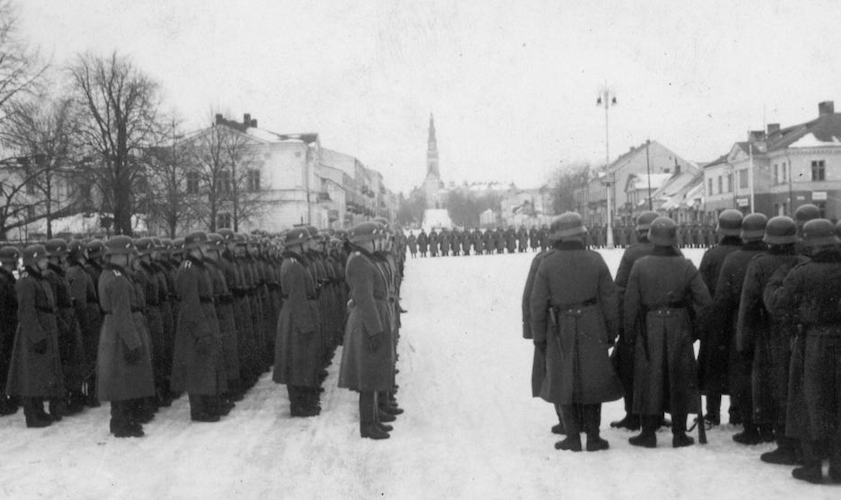During the military operations on Poland’s territory in September 1939. Germans committed several crimes, whose victims were prisoners of war and defenceless civilians. Their perpetrators turned out to be not only members of the specially created before the German aggression of 1 September 1939 Einsatzgruppen (Operational Groups), but also often Wehrmacht soldiers.
Less than ten days before the attack on Poland, on 22 August 1939, Adolf Hitler’s orders were given at a meeting of the higher commanders in Berchtesgaden, which were meticulously carried out during the September 1939 campaign.
“The destruction of Poland is in the foreground. The aim is elimination of living forces, not the arrival at a certain line. Even if war should break out in the West, the destruction of Poland shall be the primary objective. I shall give a propagandist cause for starting the war -never mind whether it be plausible or not. The victor shall not be asked later on whether we told the truth or not. In the cases of starting and waging war, it is not the law that decides, but victory. Be without mercy, be brutal.”
The achievement of the above criminal objectives would not have been possible without the creation of the Einsatzgruppen (Operational Groups). The framework for their activities was defined by the Reich Security Main Office (RSHA). In July 1939, on the basis of an agreement with the Wehrmacht command, 5 Einsatzgruppen units were formed, which were later assigned to each of the German armies preparing for the aggression against Poland. In September 1939, two further groups were formed to follow the Wehrmacht units deep into Poland. Their task was to apprehend persons whose data had been prepared in proscription lists based on the “List of enemies of the Reich “Sonderfahndungsbuch Polen”, created in 1939.
On the basis of instructions from Adolf Hitler himself, the commanders of the Einsatzgruppen had the right to decide on the execution of detained persons suspected of resistance, even without a decision by the police summary courts. The proscription lists included participants in the Silesian uprisings and the Greater Poland Uprising. It is assumed that in the September-October 1939 period, these groups conducted nearly 1,000 executions, in which about 50,000 people were murdered. The whole operation was given the code name ‘Tannenberg’, which probably symbolically signified bloody revenge for the defeat at Grunwald in 1410. As part of this criminal activity, Einsatzgruppen officers were very often supported by members of the ‘Selbstschutz’, a paramilitary formation grouping representatives of the German national minority who lived in Poland.
In September 1939, war crimes against defenceless civilians and prisoners of war were also committed by Wehrmacht units, amid which an anti-partisan psychosis prevailed. It was fuelled by German propaganda which argued that the Poles were a treacherous and deceitful nation. On the night of 1 to 2 September 1939, a shootout broke out in the German-occupied border village of Torzeniec in Greater Poland, resulting in the deaths of three Germans. It was most likely the result of panic and the Wehrmacht soldiers firing at each other. However, it was believed to have been an attack by Polish residents, which resulted in the murder of 16 Poles and the setting of several buildings on fire. On the morning of 2 September, the commander of the German 41st Infantry Regiment ordered all the villagers to be gathered and, after separating, all the men were sentenced to death. The capital punishment was immediately carried out on every second sentenced person. A total of 19 people were murdered in this way. At the same time, another German unit completely burnt down the neighbouring village of Wyszanów, murdering 22 people, including women and children.
On 4 September 1939, soldiers from the 46th Infantry Division murdered about 500 civilian inhabitants of Częstochowa (Poles and Jews). The background was the same as described earlier in Torzeńec. The detainees were kept in the city squares and then shot and buried in anti-aircraft ditches. None of the perpetrators of this crime were ever held accountable in any way. A few days later, several thousand Poles were murdered in Bydgoszcz. This was in revenge for the events of 3 and 4 September, when 300 Germans (mostly trained saboteurs shooting at Polish troops retreating from the city) were killed.
Yet another example of the German crime: on 18 September 1939 in Śladów, near Sochaczew, the Germans, murdered around 300 people by the Vistula River, half of whom were prisoners of war and the other half residents of the surrounding villages. One of the survivors recalled the crime: “When they started shooting, the Polish soldiers started jumping into the Vistula. I did the same, only the difference was that I immediately squeezed under the bank and from there I could observe well what was happening on the Vistula River. The soldiers were swimming, and the Germans were shooting at them like wild ducks, so that none survived”. The perpetrators of this cruel crime also escaped responsibility for it, as, unfortunately, for many other crimes.





